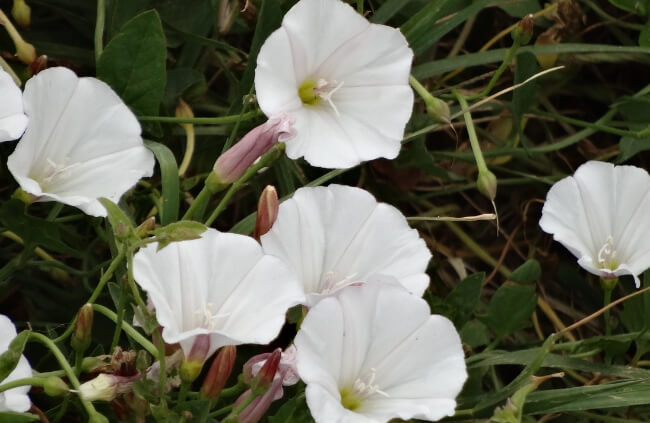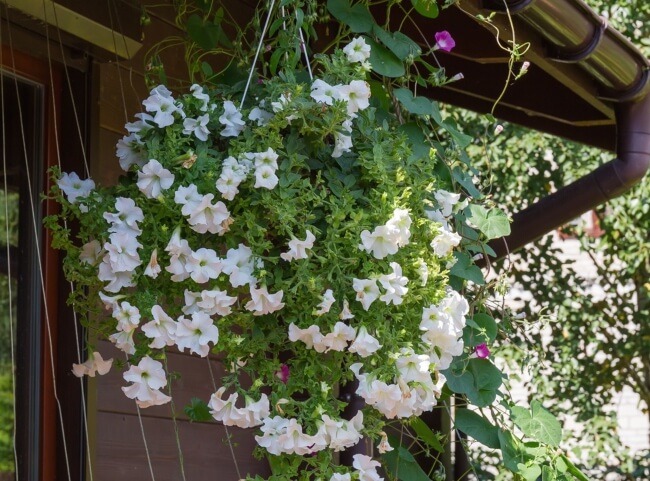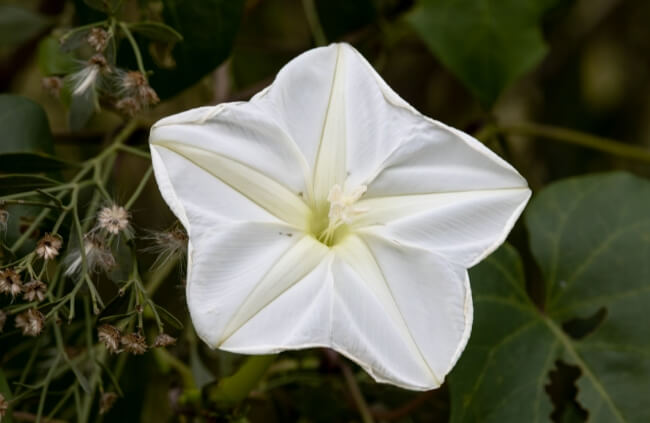I remember being amazed by the idea of a moonflower as a child. Flowers that only bloomed at night and that were big and sweet smelling seemed a bit like a fairy tale. The moonflower vine is one of those wonderful garden discoveries that feel other worldly.
In our guide, we introduce you to the moonflower in a bit more detail. We’ll share how to propagate this vine both from seed and cuttings, and how to care for the plant for a happy and long lasting relationship.
More...

Family: | Convolvulaceae |
|---|---|
Genus: | Ipomoea |
Species: | I. alba |
Origin: | North and South America |
Common Names: | Moonflower vine |
Location: | Indoor and outdoor |
Type: | Vine |
Growth: | Up to 6 metres tall and 1.8 metres wide |
Sun requirements: | Full sun |
Foliage Colour: | Green |
Flower Colour: | White |
Flowering: | Summer to autumn |
Edible Parts: | None |
Maintenance level: | Average |
Poisonous for pets: | Yes |
Introduction to Moonflower Vines
Moonflower, also known botanically as Ipomoea alba, is a much loved climber and it was considered fashionable to have one in your garden during the 1980s.
The moonflower vine is impressive, with big and perfumed flowers and leaves shaped like hearts. The flowers begin opening in the late afternoon and leave a lingering perfume in the air during the night.
Ipomoea alba is often confused with another plant sharing the moonflower name. Datura stramonium is part of the nightshade family and has common names like devil’s weed and moonflower.
Datura also has big white flowers with a perfume scent, but its leaves are not shaped like hearts and it doesn’t grow as a vine. While both types of moonflowers are toxic, the Datura can be deadly compared to the Ipomoea alba.
How to Grow Moonflowers in Australia
When choosing a living space for your moonflower, think about shade, and also protection from wind and harsh sun. This vine grows plentifully but responds well to pruning to maintain a size and shape that you are happy with.
The moonflower could definitely be described as a hungry plant, especially during the growing phase. You can apply compost and manure in generous amounts.

Source: Horticulture Magazine
Ideal Conditions for Planting Moonflowers
Sunlight
A moonflower vine will thrive if it can grow in full sun. Partial sun is also fine but you won’t get as many flowers. Full sun exposure is ideally at least 6 hours of direct light.
Soil Preference
Moonflower vines get thirsty. They need a soil that will stay moist and can handle many different soil varieties. First prize would be a rich and loamy soil that is well-draining. A slightly acidic to neutral soil pH is recommended.
Temperature and Humidity
Ipomoea alba enjoys an environment that is hot and humid. Too much cold will kill them off. The moonflower vine is a tropical plant at heart after all. Although they do like high humidity, if you make sure your moonflower gets enough water, they can handle air that is drier.
Different Ways to Propagate Moonflowers
Propagating Moonflowers from Seeds
You are able to get seed from an existing moonflower vine when the seed pods become brown. When the pod has dried, you can open it up and remove the seeds you need. Store the seeds somewhere cool and dry until ready for planting.
To prepare the seeds when ready to plant, you’ll need to soak them overnight in some warm water. You should notice that the seeds have swollen after soaking. Any seeds that are not swollen can be soaked again.
Once this is done, you can then plant your seeds in an appropriate seed starting mixture in pots and cover them slightly with soil. Water the pots straight away and then keep them somewhere warm with good lighting.
Germination takes between 10 to 21 days and the ideal temperature range is between 18 and 22°C. Once the weather warms up you can then transplant your seedlings outside. The ideal seasons are spring and autumn.
Moon Vine Propagation from Cuttings
When taking cuttings, aim for pieces that are between 15 and 20 cm in length. Remove leaves from the lower half of the cutting and put it in a container of water to allow the cutting to root.
Alternatively you can plant the cuttings in pots filled with potting mixture. Press down the mix around the stem of the cutting and make sure the potting soil stays moist.
How to Care for Moonflowers

Watering Moonflower Vines
Moonflower vines don’t do well in full sun exposure if they aren’t getting enough water. They start to wilt and if you water them, it looks as if they are coming back to life. Young moonflower plants should be watered regularly to maintain soil that is moist but never soggy.
If there is too much water in the soil, it can cause root rot. When your Ipomoea alba is established, you can then water when the top layer of soil is dry to the touch. The plant can handle a short drought.
What Fertiliser to Use
We recommend using a fertiliser for your moonflower that has a high phosphorus content. If your plant is in a pot this is even more vital. Any fertiliser that has lots of nitrogen should be avoided.
The moonflower vine will then end up large in size but won’t have many flowers. In the summer months, you can apply fertiliser every 4 weeks.
Deadheading Moon Vines
It isn’t absolutely necessary to prune your moonflower vine. You can however deadhead any blooms that are finished which ultimately promotes more flower growth.
Moonflower Vines Pests and Diseases
Root rot
Symptoms of root rot include stems that are wilting, leaves that become misshapen and yellow, and overall slow growth of the moonflower. Often the soil actually smells rotten and if you check the roots they are a red to brown colour.
Start by rinsing off the roots to remove the soil and then cut off any rotten roots. We also recommend pruning the leaves of the moonflower vine to allow the root system to repair itself and continue to grow.
Grey mould
Grey mould fungus can spread quickly and is often diagnosed when you see brown or grey spots on your plant leaves. If left untreated, it can kill the moonflower vine.
You’ll need to remove all affected parts of your moonflower including the roots, and then start over with fresh potting soil and a new pot if you are growing your plant in one. Make sure not to overwater your Ipomoea alba as this makes the plant vulnerable to disease.
Leaf spot
The first signs of leaf spot on a moonflower vine would be tiny spots on the older leaves that have an irregular shape and which soon become black. You can treat your moonflower plant with a sulphur or copper based fungicide every week when you first notice symptoms.
They prevent the spread of the disease as the spores won’t be able to germinate.
Moonflower Vines Frequently Asked Questions

What do I need to know about potting and repotting moonflower vine?
You can grow moonflowers quite easily in a pot provided it has a climbing structure to wrap around. Ipomoea alba growing in a pot will be smaller than a plant grown in the ground.
It will need more water if grown in a pot and its sensitivity to cold is heightened. Luckily, the moonflower vine doesn’t need to be repotted.
What other plants use the name moonflower besides the very toxic Datura variety?
There are 2 worth noting. Ipomoea leptophylla is also known as bush moonflower or bush morning glory. Ipomoea violacea is often called beach moonflower or sea moonflower.
How do I get my moonflower vine to flower?
Moonflowers are usually in bloom all summer. You can deadhead any flowers that are accessible but the plant will carry on flowering regardless if it’s getting sufficient sunlight and water. Adding fertiliser to your moonflower vine when you water is also a good tip for boosting flowering. A high phosphorus content is ideal.
What does it mean if the edges of my moonflower leaves are damaged or diseased?
This probably means your moonflower vine is under attack with black rot. This is a type of bacterial disease and in the later stages, your plant will start to lose its leaves.
A great way to solve this problem and prevent future disease is to space out your plants to create better circulation. It’s also possible that your plant is being overwatered.
It helps to untangle the vines of your moonflower for more space. When it comes to watering, avoid watering at night and don’t water the plant from overhead.
What are some of the causes of yellow leaves on my Ipomoea alba?
There are a few nutrient deficiencies that could cause this to happen. If you notice yellow patches on older leaves that appear between the leaf veins, it could be a magnesium deficiency.
Often the leaf veins stay green but the centre of the leaf is yellow which eventually spreads to the edges. An iron deficiency could also be the cause but usually affects newer leaves first at the extremities of the moonflower vine, like the top and tips of the branches.
If leaves are completely yellow and newer leaves are yellowing first, a sulphur deficiency could be the cause. In the case of the edges of leaves being bright yellow but the centre of the leaf staying green, this is caused by a potassium deficiency.
In this case, the older leaves are affected first. If your Ipomoea alba is yellow all over and this discolouration begins with the older leaves that are closest to the vine and then affects newer leaves, it’s most likely a nitrogen deficiency.
What is causing my moonflower seedlings to die?
Affected seedlings might have what is called damping-off disease and it doesn’t mean that seedlings are not healthy if attacked. Your best defence against this disease is to make sure you don’t give the seedlings too much water.
Space plants to allow for good air circulation. We also recommend using an appropriate seed starting mixture instead of potting soil when first planting your moonflower vine seeds which will provide better drainage.
Get more garden inspiration when you sign up for our newsletter.
Wrapping Up Our Guide to How to Grow and Care for Moonflower Vines
Having a garden that is even more beautiful at night makes the moonflower so charming. The impressive white flowers are quite a sight and the lovely perfume that fills the air is delightful. You can plant your moonflower vines near a patio and even use it as a fence covering.
Published on September 12, 2023 by Gary Clarke
Last Updated on February 24, 2024




